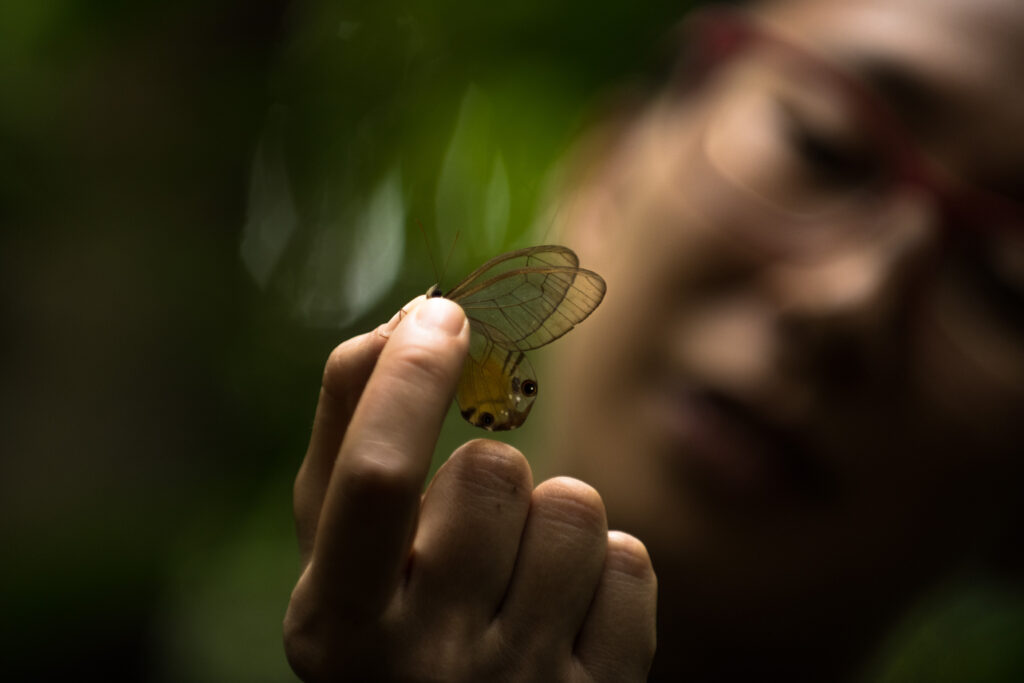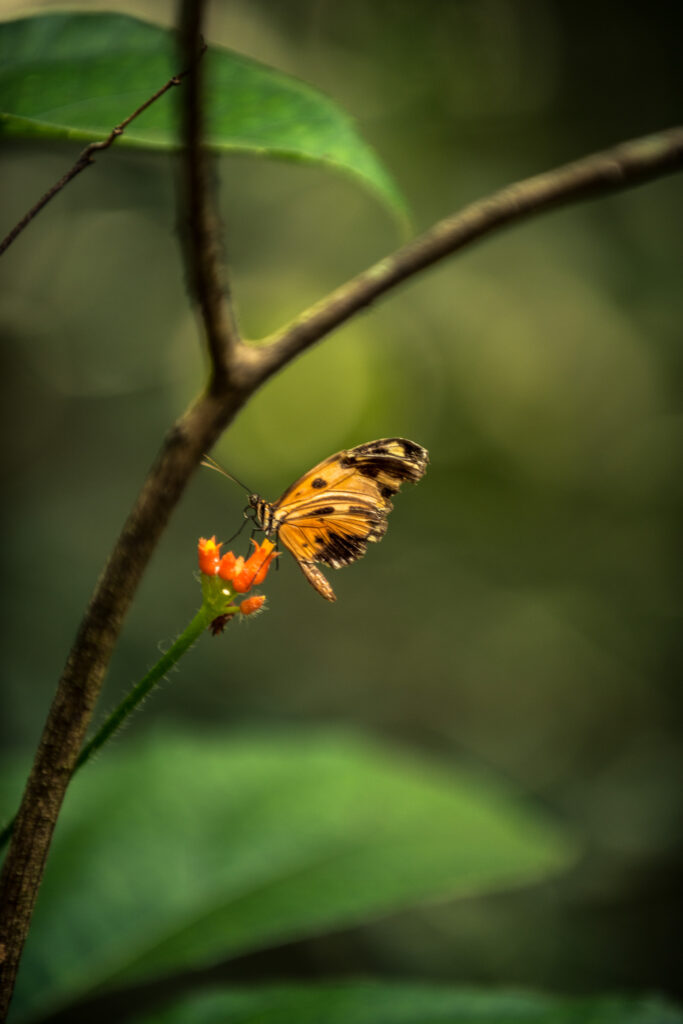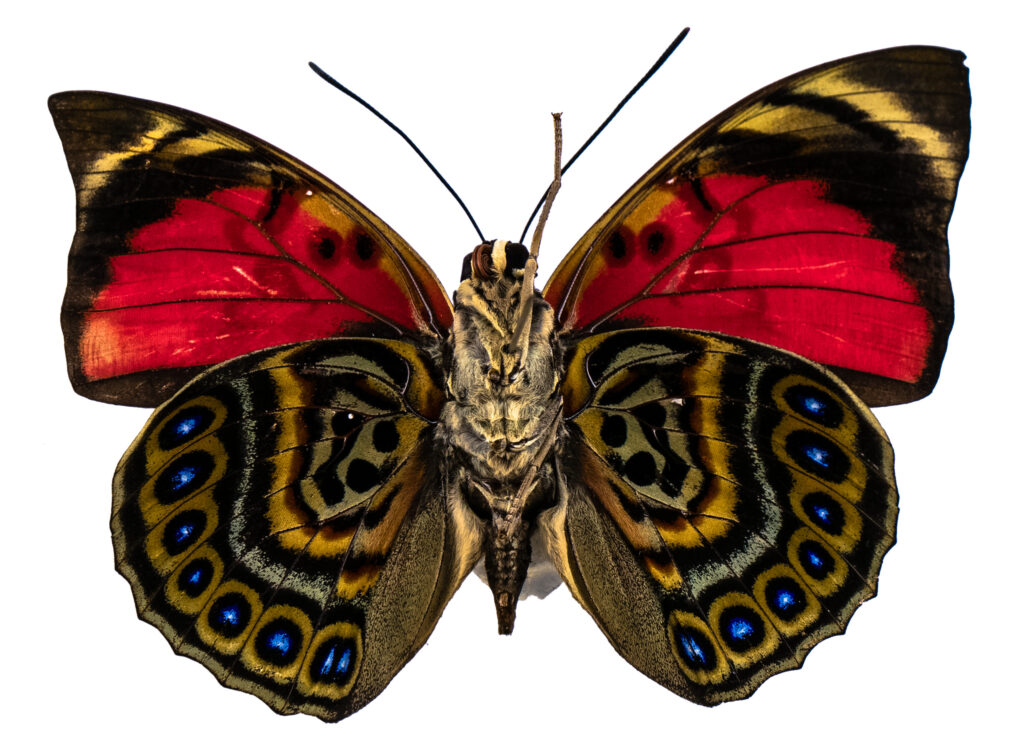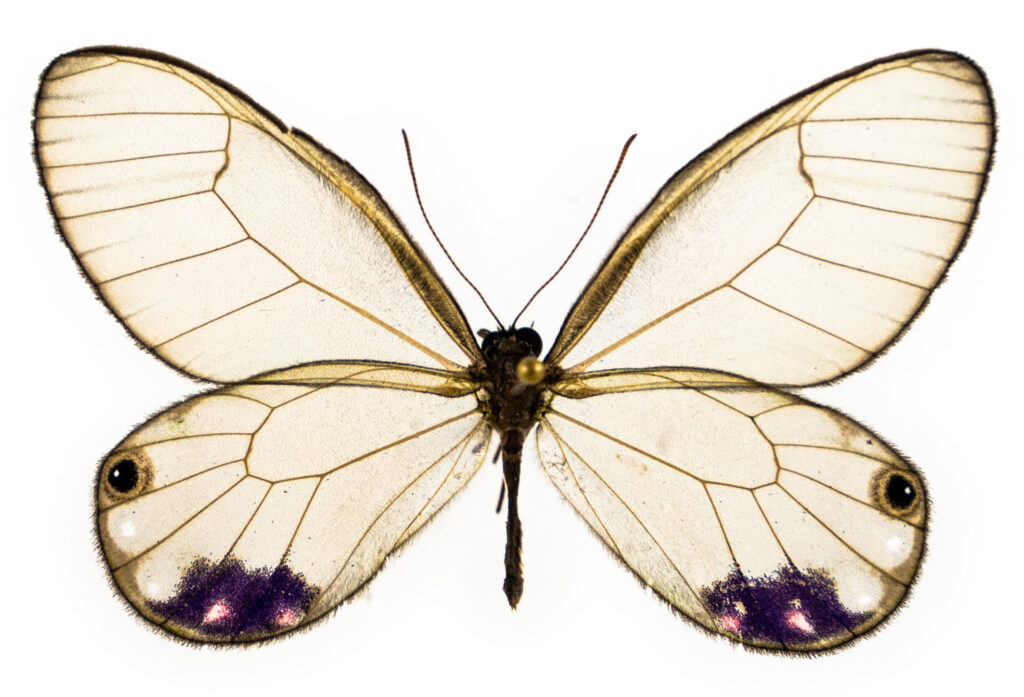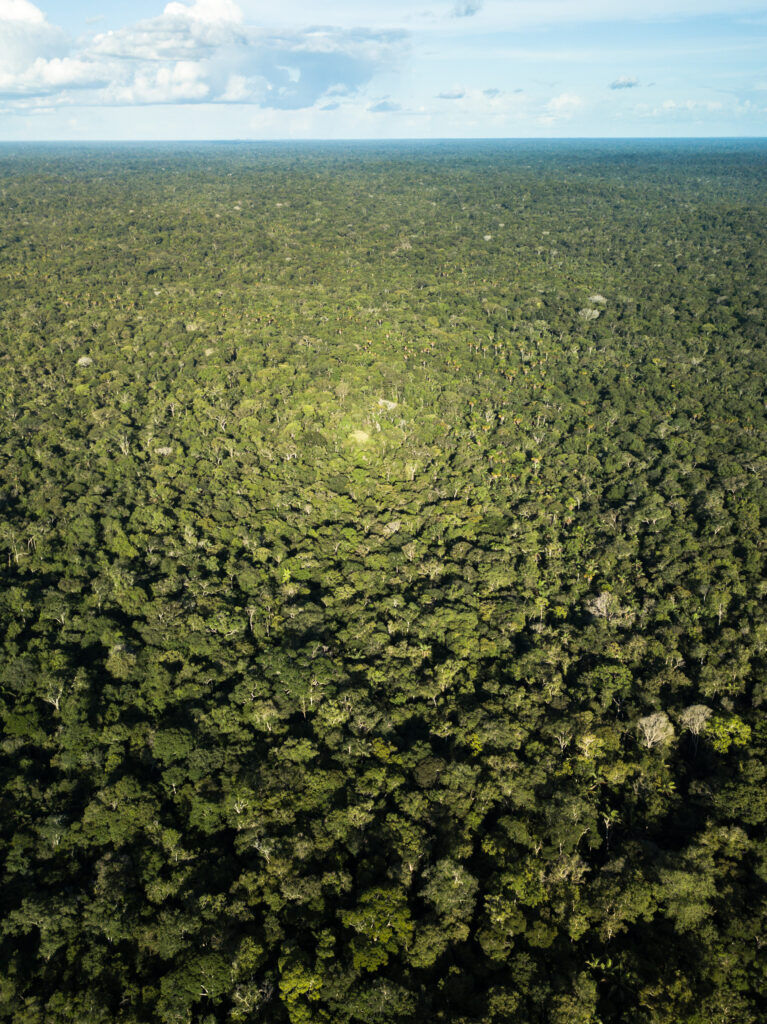Butterflies of the Amazon
National Geographic Society
Brazil, 2019
More species are found in the lush tropical forests of the Amazon basin than anywhere else on earth, and few animals epitomize this diversity better than butterflies. This documentary follows a team of biologists on an expedition to unravel the mystery of why there are so many different kinds of butterflies in the region. As the story of the expedition unfolds, the striking beauty of the butterflies is juxtaposed with images of the devastation wrought by widespread deforestation.
Produced by: National Geographic Society, Unicamp, Fapesp, USAID, Earth Journalism Network
Director: Fábio Nascimento
Researchers: Neil Rosser (University of York, UK), Leila T. Shirai (State University of Campinas, Brazil)
Written by: Fábio Nascimento, Neil Rosser, Leila T. Shirai
Cinematography, Editing, Soundtrack: Fábio Nascimento
Motion Graphics: Pilatos Almeida, Daniel Carezzato de Almeida
Sound Design: Henrique Ligeiro
IN 1848, THE ENGLISH NATURALISTS HENRY WALTER BATES AND ALFRED RUSSEL WALLACE SET SAIL FROM LIVERPOOL FOR THE BRAZILIAN AMAZON. WALLACE RETURNED AFTER 4 YEARS, BUT BATES LIVED 11 OF THE BEST YEARS OF THIS LIFE IN THE SOUTH-AMERICAN JUNGLE. THE OBSERVATIONS THAT THEY MADE DURING THIS TIME WERE CRITICAL TO DEVELOPING THE THEORY OF EVOLUTION.
At dawn, lurking in a dirt side road by BR-174, Neil Rosser, researcher at University of York, in England, points to
a shrub with flowers, a Psiguria, and says that in a few moments Heliconius butterflies will arrive for breakfast. It’s before 6am and there is a sudden rupture between the crispness of the night 300km north of Manaus and an equatorial sun, and sweat breaks out with the slightest first moves.
“Usually, when we think about territoriality, we think about mammals, we don’t think about butterflies, but they have a very specific territory. During the day, they forage in the surrounding forest, but they always sleep together, in the same places, and eat from the same plants”, explains Rosser, who also adds that groups can include members from one species only or sometimes from different species, and that not every species is social, some also sleep alone.
Both male and female are interested in searching for flowers to extract nectar and pollen. Nectar gives them energy, pollen gives them amino acids, allowing them to live six months or even more,
and they keep producing eggs their whole lives. Besides searching for flowers, males are obviously interested in females. They patrol places where they think they might find a female, and they have been seen chasing other males away. Females, if they had been mated, spend their time searching for their species of Passiflora to lay their eggs. So, butterflies learn where flowers and Passiflora are in their territories, and where the best places to find a female are. They spend their days moving around their territory, visiting flowers, etc. And at the end of the day, they go back to sleep in their groups.
In 1848, the English naturalists Henry Walter Bates and Alfred Russel Wallace set sail from Liverpool for the Brazilian Amazon. Wallace returned after 4 years, but Bates lived 11 of the best years of this life in the south-American jungle. The observations that they made during this time were critical to developing the theory of evolution. The observations that they made during this time were critical to developing the theory of evolution. They sent plants and animals that they collected to Europe, where they were preserved in natural history museums. Museums can be considered biodiversity libraries, documenting the aspects of the life of each species; they are also the place where they can be found. In the 21st century, these “books” are being digitized and used to map the world’s biodiversity.
For example, if we use museum specimens to map the colour pattern diversity of Heliconius butterflies, we can notice an impressive new pattern: a zone of high diversity that crosses the middle of the Amazon, along the course of the Amazon river. Curiously, we can also notice a similar pattern if we make maps of bird diversity.
While in the Amazon, Wallace noticed that he was always spotting different species of monkeys on both sides of the great rivers. He saw that “the native hunters are perfectly acquainted with this fact, and always cross the river when they want to procure particular animals”. This observation became the embryo of an idea, according to which rivers are barriers that divide populations, allowing different species to evolve on both sides. Does this also apply to butterflies? Back then when Bates and Wallace were in the Amazon, the only way to travel through the forest was by boat; so much so, every museum specimen from that time came from locations close to rivers and other water bodies. To this day, there are very few roads in the Amazon. Therefore, finding a high butterfly diversity close to rivers might have occurred simply because this was the only location used by biologists to collect samples.
In the 1970s, the Brazilian government began the construction of the BR-174 highway, beginning in Manaus, in the middle of the Amazon, going north, to the Venezuelan border. In 2016, a group of researchers led by Neil Rosser, from University of York, and Leila Shirai, from UNICAMP, set off on a 3-month expedition to collect butterflies along this road. Systematically collecting samples along 1,000km in the Amazon, scientists wanted to know if there is a real high diversity around the Amazon river. Besides that, they wanted to broaden their knowledge in the butterfly fauna in central Amazon and to collect data in order to test other hypotheses on how species evolve.
The expedition started in the heart of the Amazon basin, in Manaus, a city that had been an old settlement located in the confluence of two rivers, the Solimões river and Rio Negro, that together form the Amazon river. The muddy brownish waters of the Solimões river drain the young soil in the Andes, which is rich in nutrients. On the other hand, Rio Negro is a river with tea-like dark waters, draining sandy soils, which are poor in nutrients, in the north of the Amazon. These rivers are huge: close to Manaus, Rio Negro can be 20km wide. Altogether, the Amazon river system contains around 20% of world’s freshwater.
In order to collect butterflies, the team is divided into groups. Some use traps to collect the specimens; they are filled with baits made of rotten and fermented bananas, which attract frugivorous butterflies. These traps are placed on treetops, in the canopy layer of the forest, attracting species that were never seen on the ground before. However, not all butterflies are attracted by traps. Some are collected with nets. While the last sunbeams enter the dense forest, Leila Shirai uses a hairclip to close the lower part of the trap that had been set in the previous day. The trap consists of a black screen vertical cylinder, suspended by a nylon thread at different heights, and attracts butterflies using a mixture of mashed banana and brown sugar. After fermenting for 2 days, the smell of banana attracts frugivorous butterflies, and after going inside through a small opening in the basis they are not able to go out anymore. Inside, several butterflies and moths are floundering, whereas some seem to be calmer, just waiting for the Unicamp researcher to come. Leila stretches her arm, and with great prowess and delicate fingers gets a blue morpho. “This blue color is not a pigment color. They are properties of the cells. Depending on how the light strikes it, it shines in different colours.” While carefully closing its wings, the evolutionary biologist gets an envelope, where butterflies are kept. “I’m aware of each and everyone that I kill”, says in a tone that ranges from humour to worry.
From the first to the last lights of the day, the team of researchers relentlessly work, and at night an enormous meticulous work of cataloguing the collected butterflies goes on. “We have to make sure that these arrive safely in Campinas. So all this work is for these precious samples. If we don’t do this, we lose track of important information, and then the samples may become useless.”
After 3 months in the field, more than 3,000 specimens are sent to the University of Campinas, in São Paulo, where they are to be fixed, mounted and to receive a label with details such as when, where, how and by whom they were collected. All this information is organized as data and will be available online for free so that researchers from all over the world can access this biodiversity library. Just like the Blue Morpho, the Heliconius are also colourful butterflies widely common in the Amazon. Wallace suggested that the latter is poisonous and that their bright colours work as a warning sign to possible predators, by saying “don’t eat me, I’m poisonous!”. Bates was also fascinated
by these butterflies. He noticed that wherever he went different butterfly species had the same color pattern. And every hundred kilometres, all of them changed their colours to a different pattern, “as if they had been touched by a wizard’s wand”, he wrote. Bates thought that maybe they were imitating each other, that maybe they weren’t poisonous and just pretended to be. Today, this phenomenon is called Batesian mimicry and became a classic example of the theory of evolution.
Later, Bates ideas were developed by Fritz Muller, a German immigrant who came to Brazil. Through mathematics, Muller showed that, if two poisonous species had the same colour pattern, they could help themselves sharing the effort of educating predators that they are poisonous. This mutually beneficial interaction helps both species to survive and is known as Müllerian mimicry.
Some days, butterflies are simply not seen. Or at least not where we are looking for. After almost a whole day like this, two Heliconius show up, in an unusual flight; they seemed to be dancing. The pair came closer, and the ball lasted for over five minutes. A couple was performing a mating dance: one would move much more intensely, flying over the other, seemingly wanting to attract it. Later on, Neil Rosser explains that it is a very rare phenomenon to be seen in nature, even rarer to be filmed; in that case, it was even more special: the two butterflies had different wing patterns. One belonged to a region to the south, close to the Amazon river, and the other one to the north. “They are not from different species, but they are definitely two different butterflies copulating.”
Around 650km north of Manaus, the forest gives place to a great savanna, that goes up to Venezuela and Guiana. The transition from forest to savanna can be extraordinarily abrupt, and this is considered to be a fundamental ecological issue. Why isn’t the transition more gradual? Why doesn’t the forests substitute for the savanna? The answer seems to be in the arrangement between rain, soil type and more specifically fire. Even though they are not as famous as the African ones, the South-American savannas hold even more vertebrate species.
However, finding butterflies in the plains can be hard. But, even there, there are some forest areas that can be full of butterflies. Relatively smaller, the butterflies found in the savanna to the north are the ones which are subjected the most to the barrier imposed by the river in the south of the transect. Preliminary analyses of geographic data show that there is indeed a great diversity of colour patterns in Heliconius found immediately around the Amazon river. Therefore, we can conclude that the high diversity pattern around the river indicated by the museum data is real. “Now we can develop ideas to explain why this happens. Probably, rivers are barriers to butterflies, allowing populations to evolve differently on either side of the river. However, sometimes butterflies manage to cross it, making forest areas around the river prone to holding an exceptionally high diversity.” Neil seems to be constantly excited by the invisible details of the expedition. “We normally think about evolutionary barriers as being mountains or other more evident things. At first glance, the Amazon seems an immense continuum of life. But the butterflies are showing us that the river can work as a watershed in the species evolution.
Located around 100km north of Manaus is the huge Balbina reservoir. It was created for a hydroelectric dam, a project that flooded 3,000 square meters
of forest. Besides flooding big areas, the dams also had severe consequences to the aquatic life, since it interrupted the fish migration – as well as other animals – along the rivers. “Sadly, even though Balbina creates job posts locally, it produces only a fraction of its estimated electric production. The dams are only one of the problems in the long list of environmental issues the Amazon faces.” Leila seriously talks about these and other impacts, as someone who thinks about the whole biome. “At the same time this road allows us to collect butterflies along the transect, it also expands the deforestation borders. Collecting these butterflies now can be decisive; shortly everything can be gone and there will be nothing to tell us the story of how this region was in the past.”
Around 20% of the forest has been destroyed, mainly for areas dedicated to cattle farming. So much so, many species are probably being extinct even before we know about their existence. Forests are also vital to global climate regulation since they produce great amounts of oxygens and absorb carbon dioxide, the main responsible for global warming. Its destruction could, consequently, change not only South America but also the Earth itself. Isolated indigenous people, sometimes described as “the last free people on the planet”, are also the most vulnerable ones. Tragically, they are more and more in contact with land-grabbers, loggers, illegal artisanal miners and drug dealers. Their chances are not good.
The Amazon forest was essential in the development of one of the most important ideas in the history of mankind. It comprises an immense proportion of global biodiversity and unprecedented carbon stocks. What the future holds is uncertain. We hope that future generations are able to be awestruck by its staggering biodiversity, the same way Bates, Wallace and many orders were before.


